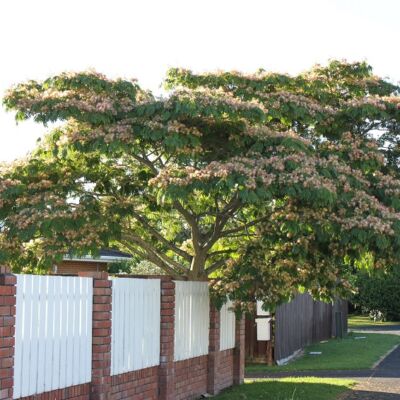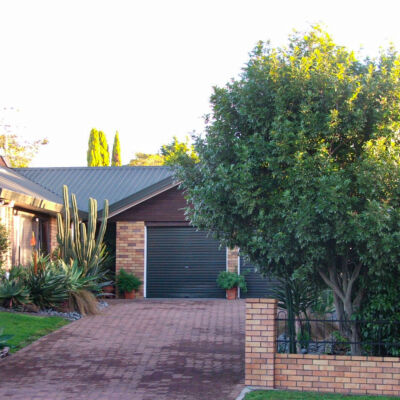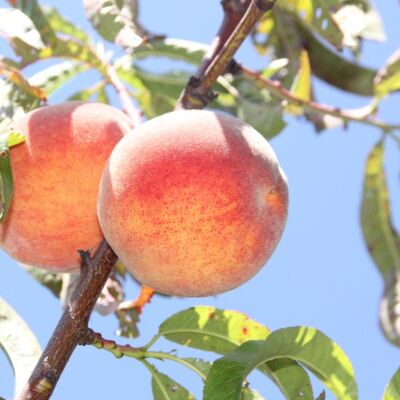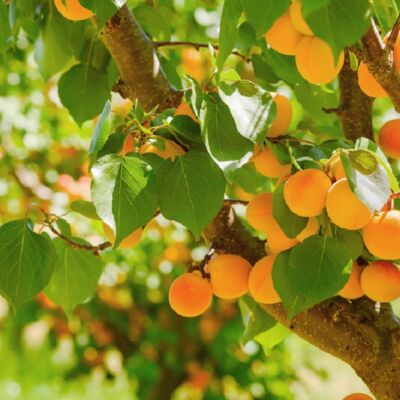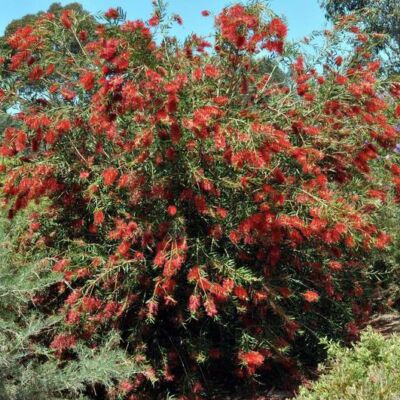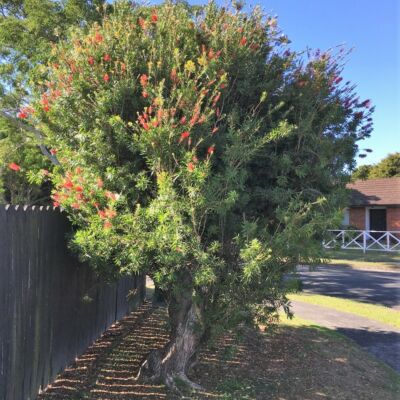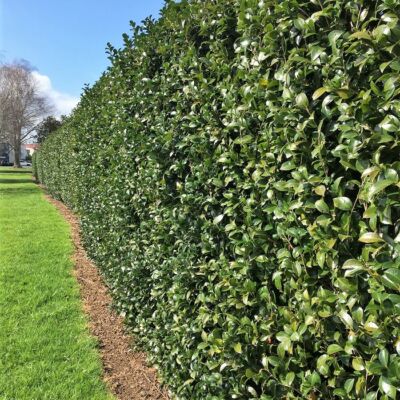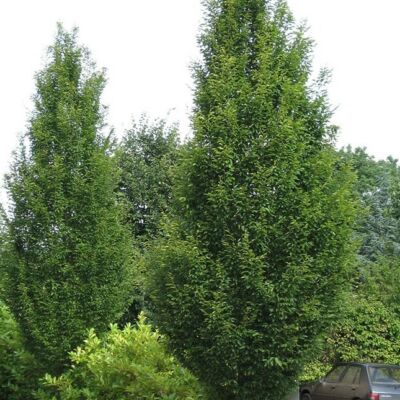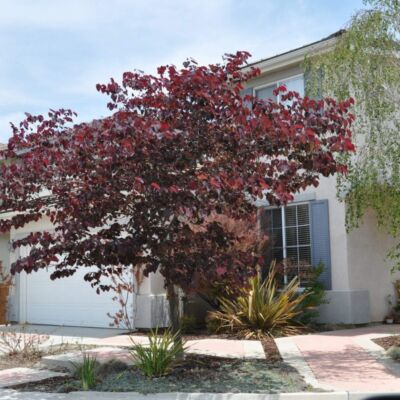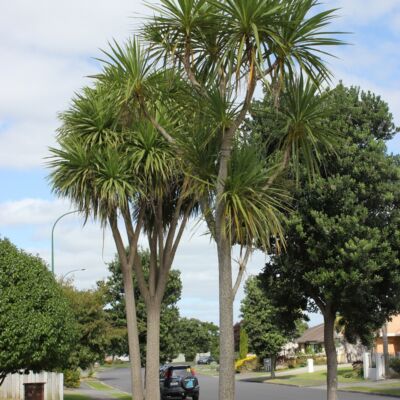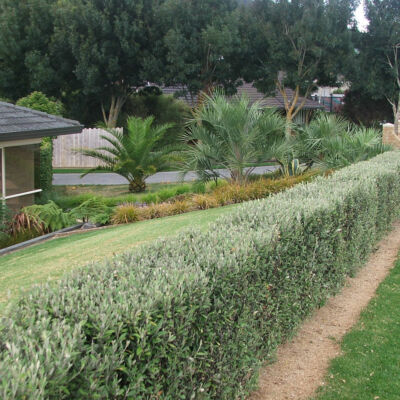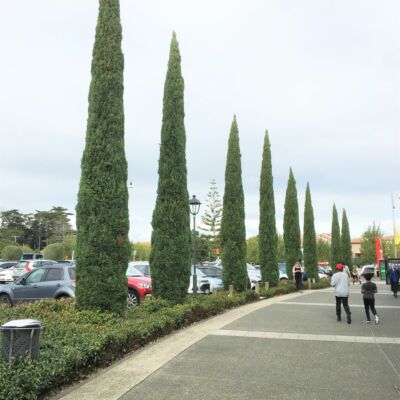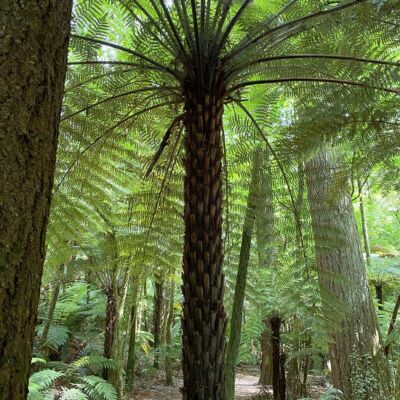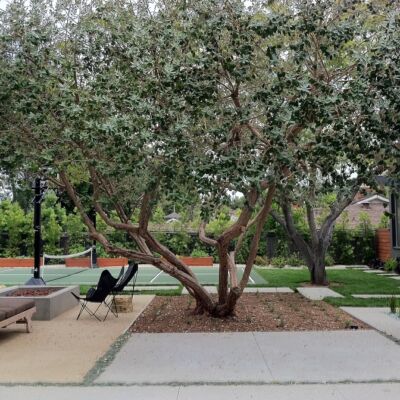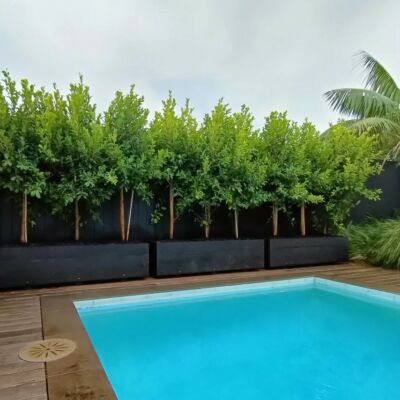|
A quick growing, smaller, spreading tree. Rich green, ferny leaves. Flowers during summer on top of leaves, open as rounded fluffy brushes of pink. Tolerates hot dry areas once established. Excellent shade tree. |
| Height x Width | 5 x 4 |
| Height Range | Medium 5-10m |
| Growth Rate | Fast |
| Plant Type | Tree |
| Shape / Habit | Spreading |
| Country of Origin | Asia, China |
| Similar to Consider | Jacaranda, Gleditsia, |
|
|
| Leaf Colour | Green |
| Deciduous Leaf Colour | Brown |
|
|
| Flower Colour | Pink |
| Fragrant? | No |
|
|
| Specimen | Yes |
| Good Shade Tree? | Yes |
| Note: Growth, height and information are given in good faith but are subject to natural variables beyond our control. | |
As our cities grow bigger our yards become smaller. These trees are ideal for the smaller gardens.
-
-
- Description
One of the most popular native trees with almost black bark and glossy dark green leaves which are made up of several serrated leaflets. Sprays of rusty woolly petal-less flowers occur in early summer and present a curious reddish-brown effect. These are followed by small red fruit which attract birds. Prefers sheltered conditions in full sun in rich free-draining soil. Ideal as a specimen tree. Will grow apx 7 x 3m Height x Width 7 x 3 Height Range Medium 5-10m Growth Rate Moderate Plant Type Tree Shape / Habit Round Country of Origin New Zealand Similar to Consider Alectryon grandis, Vitex Lucens, Dysoxylum Spectabile, Planchonella costata, Myrsine salicina Leaf Leaf Colour Green - Flower
Flower Colour Red Fragrant? No - Uses
Specimen Yes Good Shade Tree? Yes Screening Yes Note: Growth, height and grade information are given in good faith but are subject to natural variables beyond our control. -
Apple TREES are cultivated worldwide and are the most widely grown species in the genus Malus. The apple is a deciduous tree, generally standing 2 to 4.5m tall having its origins in Central Asia. When cultivated, the size, shape and branch density are determined by rootstock selection and trimming method. LEAVES are dark green simple ovals with serrated margins. Blossoms are produced in spring at the same time as leaves. FLOWERS are generally white with a pink tinge. The FRUIT matures in late summer or autumn. Different CULTIVARS are bred for various tastes and use, including cooking, eating raw and cider production. Sometimes hand thinning is necessary to avoid overstressing the tree, which may result in a poor crop the following year. However this should not be done until mid-December when the natural fall is complete. ROOTSTOCKS are used to control speed of growth and the size of the resulting tree allowing for easier harvesting. Apple Root Stock: M26: Very Dwarf tree, Under 3.0m M.9 Dwarf tree, To Apx 3.0m, Suits well drained fertile soils. Requires support system: MM106 Semi dwarf tree, To Apx 4.5m. Good on most soils except poorly drained soils MM 793 Larger tree, To Apx 6.0m. Better suited to difficult soils (heavy or clay) Northern Spy Semi dwarf tree. To Apx 3-5m. Wetter ground and Clay. Resistance to woolly aphids. Harvest Season (Apx): EARLY = Jan – Feb. MID = Feb – March. LATE = April – May Make enquiries as to which varieties we have available now or see our online catalogue.
-
Originally domesticated in China, apricots are grown successfully around the world. These small TREES are a manageable size for the home orchard growing to around 4-5m tall. FLOWERS appear in spring with FRUIT (a drupe similar to a small peach, ranging in colour from yellow to orange) ready to harvest Dec - Feb. As they are self fruiting, you typically don't need two apricot trees to produce fruit. They are relatively easy to grow and will produce loads of fruit year after year that can be enjoyed fresh from the tree, made in to jam, bottled or dried. Apricots we supply are better suited to warmer climates. HARVEST is from Dec - Feb. Make enquiries as to which varieties we have available now or see our online catalogue.
-
- Description
A vigorous small tree with long, narrow green leaves with slightly pendulous branches. Bright red flower spikes carried in clusters over spring and early summer provides nectar for bees and birds. Tolerates coastal, wind, clay, sandy or dry once established. Height x Width 3 x 2 Height Range Small 1-5m Growth Rate Fast Plant Type Tree Shape / Habit Round Country of Origin Australia Similar to Consider C. Red Clusters, Salignus (Yellow) Citrinus Violetii (Violet) - Leaf
Leaf Colour Green - Flower
Flower Colour Red Fragrant? No - Uses
Screening / Shelter Yes Hedging Yes Bird Feeding Yes Note: Growth, height and grade information are given in good faith but are subject to natural variables beyond our control. -
- Description
Vigorous large shrub, new leaves emerge a silvery-pink turning to mid- green. Masses of red bottlebrush flowers with gold anthers appear in spring and autumn. Tolerant of poor dry soils once established, though prefers some moisture. Provides nectar for bees and birds. Good for hedging. Height x Width 3 x 2 Height Range Small 1-5m Growth Rate Moderate Plant Type Shrub Shape / Habit Round Country of Origin Australia Similar to Consider Kings Park Special, Salignus (Yellow) Citrinus Violetii (Violet) - Leaf
Leaf Colour Green - Flower
Flower Colour Red Fragrant? No - Uses
Screening Yes Hedging Yes Bird Feeding Yes Fruit Producing Note: Growth, height and grade information are given in good faith but are subject to natural variables beyond our control. -
- Description
Pure white medium semi-double. Slight fragrance early season. Upright rounded form. Trims well so ideal for hedging and topiary. Plant in full sun or dappled shade in well drained acidic soil. Prune after flowering to maintain shape. Height x Width 2.5 x 2.0 Height Range Small 1-5m Growth Rate Moderate Plant Type Shrub Shape / Habit Round Country of Origin China Similar to Consider Other Camellias, Laurus Nobilis, Prunus lusitanica, Michelia Figo, Syzygium resilience, Pittosporums, Corokia, Griselinia, Ficus, Ilex largo, Olea El Greco, Eugenia Ventinatii - Leaf
Leaf Colour Green - Flower
Flower Colour White Fragrant? Yes - Uses
Hedging Yes Note: Growth, height and grade information are given in good faith but are subject to natural variables beyond our control. -
- Description
A narrow upright form of Carpinus Betulus. Gradually widening with maturity. Oval ribbed green leaves that have good autumn colouring of yellows and oranges eventually turning brown and remaining on the tree for long periods over winter. Excellent Street or Avenue tree or shelter belt if planted closer together. Very hardy Height x Width 8 x 3 Height Range Medium 5-10m Growth Rate Moderate Plant Type Tree Shape / Habit Columnar Country of Origin Europe Similar to Consider Betula var. Cupressus totem, Liriodendron tulipifera fastigiata, Olea El Greco, Knightia Excelsa, Acer Bowall, Poplar crow’s nest, Quercus robur fastigiata - Leaf
Leaf Colour Green Deciduous Leaf Colour Golden Yellow - Flower
Flower Colour Insignificant - Uses
Accent Yes Note: Growth, height and grade information are given in good faith but are subject to natural variables beyond our control. -
- Description
A small open habit tree with a broad round head. Heart shaped leaves are purple red and appear after the magenta flowers bloom on bare branches in early spring. Excellent small specimen tree suited to smaller gardens. Tolerates Clay soil but avoid wet or poorly drained soils. Deciduous. Height x Width 4 x 3 Height Range Small 1-5m Growth Rate Moderate Plant Type Tree Shape / Habit Spreading Country of Origin North America Similar to Consider Prunus Thundercloud, Fagus Riversii, Fagus Sylv Purp, Acer Tamuke Yama, Fraxinus Raywoodii, Acer Bloodgood. - Leaf
Leaf Colour Purple Red Deciduous Leaf Colour Purple Red - Flower
Flower Colour Magenta Fragrant? No - Uses
Specimen Yes Accent Yes Note: Growth, height and information are given in good faith but are subject to natural variables beyond our control. -
- Description
Cordyline australis - Cabbage Tree Cabbage tree: An iconic New Zealand palm like tree. Long drooping slender leaves up to 1m long are clustered at the tips of the branches. Large heads of scented creamy white flowers in Nov produce nectar for bees, then fruit attracts birds from January-April. Commonly found throughout farmland, open places, wetlands and scrubland of the North and South Islands in anything from wet swampy ground to dry windy hill slopes. Hardy. Height x Width 6 x 2 Height Range Small 1-5m Growth Rate Slow Plant Type Palm Shape / Habit Upright Country of Origin New Zealand Similar to Consider Nikau Palms - Leaf
Leaf Colour Green - Flower
Flower Colour White Fragrant? Yes - Uses
Accent Yes Bird Feeding Yes Note: Growth, height and grade information are given in good faith but are subject to natural variables beyond our control. -
- Description
A slender growing shrub with rich green foliage and masses of starry yellow flowers early summer followed by dark red berries. Attracts birds. Ideal as a hedge trims well. Will tolerate dry coastal exposed or windy sites once established. Height x Width 2 x 1.2 Height Range Small 1-5m Growth Rate Moderate Plant Type Shrub Shape / Habit Round Country of Origin New Zealand Similar to Consider Syzygium resilience, Michelia Figo, Camellias, Pittosporums, Griselinia, Ficus, Ilex largo, Olea El Greco, Eugenia Ventinatii - Leaf
Leaf Colour Green - Flower
Flower Colour Yellow Fragrant? No - Uses
Hedging Yes Bird Feeding Yes Note: Growth, height and grade information are given in good faith but are subject to natural variables beyond our control. -
- Description
Selected narrow growing form with bluish-green foliage. Cutting-grown for uniform narrow columnar shape and even growth rate. Foliage stays together and doesn’t “fall out” More resistant to canker. Prefers dryish soil and no manuring. Height x Width 10 x 2 Height Range Medium 5-10m Growth Rate Fast Plant Type Tree Shape / Habit Narrow Country of Origin Europe Similar to Consider Thuja Smaragd, Liriodendron tulipifera fastigiata, Olea El Greco, Knightia Excelsa, Acer Bowall, Poplar crow’s nest, Quercus robur fastigiata, Carpinus Betulus fastigiata - Leaf
Leaf Colour Green glaucus - Flower
Flower Nil - Uses
Accent Yes Note: Growth, height and information are given in good faith but are subject to natural variables beyond our control. -
- Description
Iconic New Zealand native fern and the inspiration of the national Emblem. A tree fern with green-stalked soft leaves to apx 4m long that are distinctly silver on the underside. Trunk can grow to 10m tall. Prefers a more sheltered position as they generally grow under larger native NZ Trees. Height x Width 8 x 3 Height Range Medium 5-10m Growth Rate Slow Plant Type Palm Shape / Habit Palm Country of Origin New Zealand Similar to Consider Cyathea medularis, Dicksonia squarrosa, Dicksonia fibrosa - Leaf
Leaf Colour Green - Flower
Flower Colour Nil - Uses
Specimen Yes Accent Yes Note: Growth, height and grade information are given in good faith but are subject to natural variables beyond our control. -
- Description
The tallest and most common of NZ’s tree ferns. Slender, black trunk to apx 15m with hexagonal patterns from old fronds, large crown of gracefully arching fronds up to 5m. Found primarily in sheltered coastal and lowland forest throughout much of the North Island. They will grow in full sun but still prefer to have a sheltered position with a cool moist root run. Height x Width 15 x 5 Height Range Tall 10m+ Growth Rate Moderate Plant Type Palm Shape / Habit Palm Country of Origin New Zealand Similar to Consider Cyathea dealbata, Dicksonia squarrosa, Dicksonia fibrosa - Leaf
Leaf Colour Dark Green - Flower
Flower Colour Nil - Uses
Specimen Yes Accent Yes Note: Growth, height and grade information are given in good faith but are subject to natural variables beyond our control. -
- Description
Stout tree fern which can reach up to 6 m tall, though over a very long time, found in lowland and lower mountain forest. Distinguished by its thick fibrous, soft trunk. Fronds grow 1-2m in length forming dense crown. Dead fronds leave a tidy skirt beneath crown. While slower growing It does well in average garden conditions. This variety is suited to a sunny position or light shade. Height x Width 6 x 3 Height Range Medium 5-10m Growth Rate Slow Plant Type Palm Shape / Habit Palm Country of Origin New Zealand Similar to Consider Cyathea medularis, Cyathea dealbata, Dicksonia squarrosa. - Leaf
Leaf Colour Green - Flower
Flower Colour Nil - Uses
Specimen Yes Accent Yes Note: Growth, height and grade information are given in good faith but are subject to natural variables beyond our control. -
- Description
Wheki or Brown Ponga is a hardy NZ native tree fern. It grows a tall, slender, brown trunk to approx 6m. Fronds can reach 1.5 to 3m in length which give it the appearance of a small “umbrella” on top of the trunk. It is the most popular New Zealand tree fern which is easy to grow and maintain. Hardiness and smaller dimensions make it an excellent garden variety. Height x Width 6 x 3 Height Range Medium 5-10m Growth Rate Moderate Plant Type Palm Shape / Habit Palm Country of Origin New Zealand Similar to Consider Cyathea medularis, Cyathea dealbata, Dicksonia fibrosa. - Leaf
Leaf Colour Green - Flower
Flower Colour Nil - Uses
Specimen Yes Accent Yes Note: Growth, height and grade information are given in good faith but are subject to natural variables beyond our control. -
- Description
A small tree with a symmetrical habit. Long glossy light green leaves. Unusual yellow / green papery flower clusters in summer. Purpureum has red purple leaves and light red flowers. Will tolerate dry sandy or rocky soils, salt spray, windy areas and drought conditions. Ideal used as a wind or privacy screen and is useful in harsh conditions. Keep trimmed to maintain shape. Height x Width 3.5 x 2.0 Range Small 1-5m Growth Rate Fast Plant Type Tree Shape / Habit Spreading Country of Origin New Zealand Similar to Consider D. Purpurea. Myrsine salicina, Planchonella costata, - Leaf
Leaf Colour Green - Flower
Flower Colour Yellow green Fragrant? No - Uses
Screening / Shelter Yes Hedging Yes Note: Growth, height and grade information are given in good faith but are subject to natural variables beyond our control. -
A smaller growing bushy TREE it is one of the hardiest of the subtropical fruits, growing in most soils and tolerating several degrees of frost. Feijoas are commonly available as seedlings, but plants grown from cuttings or grafted specimens are more reliable. Attractive red and white FLOWERS also attract birds and are edible as well. FRUIT ripens between April and May and when mature will fall off the tree at a touch. The skin is green and ranges from smooth to rough and dimpled. The pulp is sweet and juicy with a good flavour. Generally require another to cross pollinate although "Unique" is unique in that it doesn't! They respond well to trimming if they become a little tall or woody and can also be used as a hardy hedge. APX: 4.0m - HARVEST: March-May Make enquiries as to which varieties we have available now or see our online catalogue.
-
- Description
Small medium tree with lush lime green leaves and drooping branches. Excellent trimmed for hedging or can also be clipped for pleaching or topiary. Height x Width 6 x 3 Height Range Medium 5-10m Growth Rate Moderate Plant Type Tree Shape / Habit Round Country of Origin Australia Similar to Consider Syzygium resilience, Michelia Figo, Camellias, Pittosporums, Corokia, Griselinia, Ficus Tuffi, Ilex largo, Olea El Greco, Eugenia Ventinatii - Leaf
Leaf Colour Green - Flower
Flower Nil - Uses
Screening / Shelter Yes Hedging Yes Note: Growth, height and grade information are given in good faith but are subject to natural variables beyond our control. -
- Description
A medium sized tree with lush lime green leaves and an upright habit. Very popular trimmed for hedging or can also be clipped for pleaching or topiary. Height x Width 4 x 2.5 Range Small 1-5m Growth Rate Moderate Plant Type Shrub Shape / Habit Round Country of Origin Australia Similar to Consider Syzygium resilience, Michelia Figo, Camellias, Pittosporums, Corokia, Griselinia, Ilex largo, Olea El Greco, Eugenia Ventinatii, Ficus Hillii, - Leaf
Leaf Colour Green - Flower
Flower Insignificant - Uses
Screening / Shelter Yes Hedging Yes Note: Growth, height and grade information are given in good faith but are subject to natural variables beyond our control.
